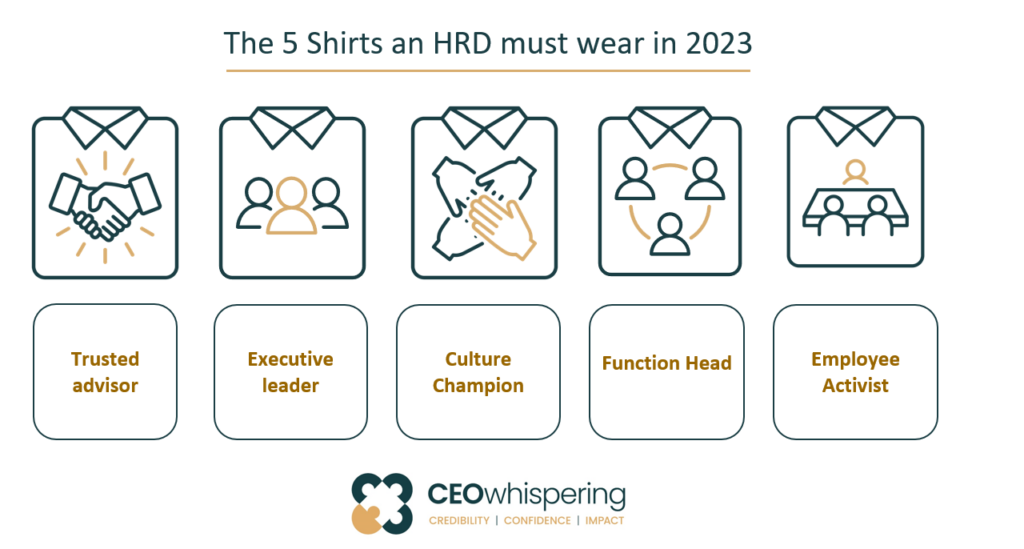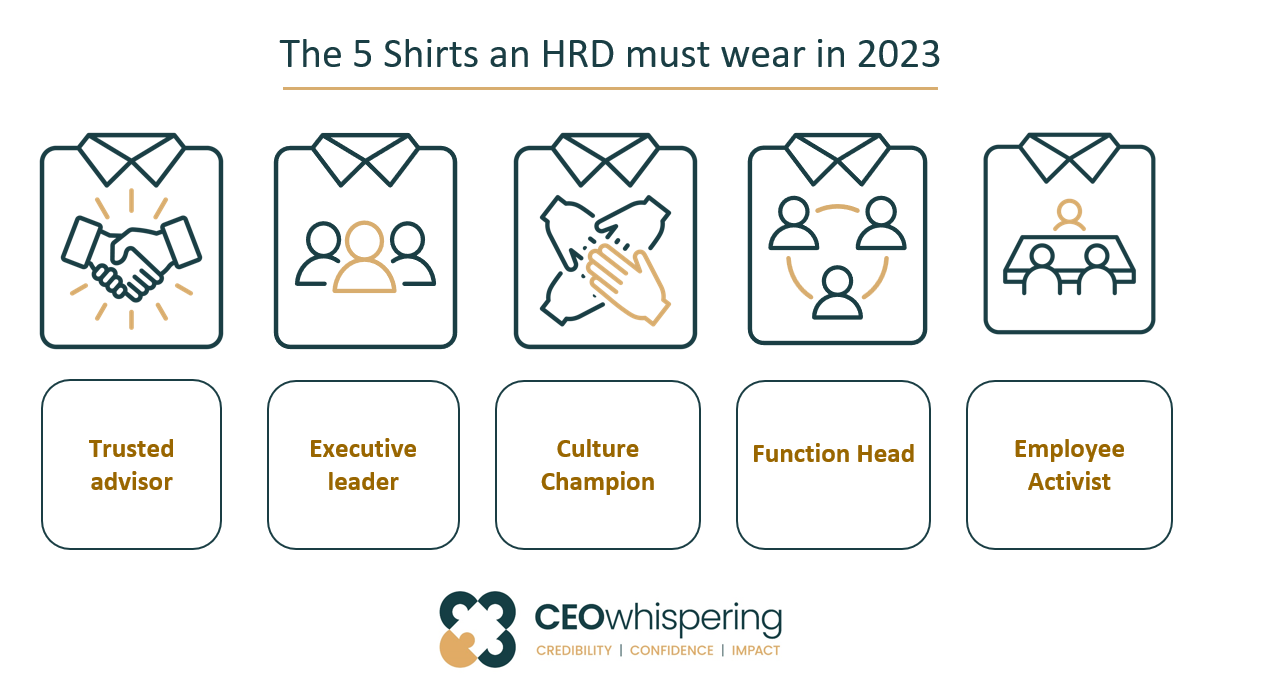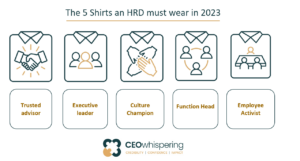In 2023 businesses are facing the triple squeeze of market turbulence, inflation and scarcity of talent. And within executive leadership teams, HR Directors are working with their CEOs and CFOs to make the difficult trade-offs between what the business needs and what their employees want, and between delivering cost savings while justifying investment in talent.
Demands on HR leaders are higher than ever: they need to square the circle between the conflicting interests of multiple stakeholders – management, employees, customers, and shareholders. No longer is it sufficient to say “…trust us, we’ll all share in the company’s success…”
Today, 4 out of 5 employees want to be seen as a person first and an employee second; attraction and retention is not about economics but about mission and purpose, the opportunity to make a positive impact for the company and for the planet. Successful HRDs must constantly switch between psychologist, peacemaker, career planner, leader, advisor, teacher, unofficial lawyer, traditionalist, and innovator…and demonstrate competence and commercial impact in all roles!
Based on our experience, we at CEO Whispering have identified 5 distinct shirts that HR leaders need to learn to wear – sometimes in sequence, sometimes at the same time, in order to address these separate and very different needs.
Over the coming weeks we’ll share our insights on each of the shirts and tips for wearing them effectively to support your business and increase your credibility with your CEO.



Shirt 1. Impact through influence – the Trusted Advisor
How should HR Directors set out to build trust with their CEO?
Rule no 1 – the CEO is the boss. But whilst there can only be one CEO at the head of the organisation, smart CEO’s surround themselves with advisers and counsellors – or ‘Consiglieri’ as Richard Hytner, Adjunct Professor of Marketing at LBS, calls them. These are trusted advisors, providing the support and space the CEO needs in order to handle the multiple challenges they face each day.
When the HR Director is wearing her (or his) Trusted Advisor shirt, she will listen, empathise and act as a sounding board to the CEO and executive team. She will be discreet, empathetic and crucially, create a safe environment for the CEO to reflect and consider offstage.
Tony Blair famously leaned on Alastair Campbell as his consigliere on political and presentational matters, and in performing this role, Sancho Panza gave direct feedback to Don Quixote when he was being ungentlemanly- and when people thought he was going mad! Similarly for today’s HRDs: whilst the CEO may make companywide announcements like ‘my door is always open…’ and ‘just write me an email….’, the reality is that few will speak truth to power, however great the temptation.
So how to establish Trusted Advisor status?
Step One – get to know your CEO: their hopes and fears, strengths and gaps. Research their hot buttons with those who know them well, and be prepared to take the first step and ask them directly how you can help them best lead the organisation.
Step Two – anticipate: see where you can take things off their plate, so that you can tell them what you’ve done for them and the organisation before they ask. When business leaders tell me they are spending over 60% of their time on people issues, I see an opportunity to ‘give them time back’ to address other issues, and ensure that the perhaps 20-30% of their time they then spend on people and organisation is targeted and value-adding.
Step Three -discretion: ensure you pick the right time and situation to be fully candid. Ensure the CEO is confident of your loyalty in public, and then be careful to identify the appropriate time to start a conversation with that key opener….‘’I owe you the truth….”. At all times the Trusted Advisor’s ego is fully under control and she is happy to remain discretely off stage, a respected team player.
How will the HR Director know she has delivered as a Trusted Advisor ?
The evidence of her success is when her CEO starts asking for advice before taking action, and then develops the habit of returning for further counsel. And then when executive colleagues also solicit her advice: after building her reputation for sound judgement AND discretion, there is no exclusivity on whom she can serve as Trusted Advisor – the organisation is the winner.

Shirt 2. The HR Director as an Executive Leader
Why is it that many HR Directors are not automatically members of the Executive team? Our people are almost always the #1 or #2 cost line in the P&L, so how is it that the leader responsible for human capital doesn’t have an automatic seat at the Executive table?
Our research has identified three principal reasons for this:
1. Expectations -in some cases it’s because of limited expectations from CEO’s for what value commercially oriented HR professionals can bring to the workforce. They have not yet seen the impact that good HR leadership can make in putting people at the centre.
2. Will – some HR Heads show a limited knowledge or interest of the business outside of the HR brief, remaining in their comfort zone of pay & rations, employee relations, and contractual matters.
3. Skill – Some HR Heads have limited knowledge of the commercial operations of the business, having joined from outside the industry.
If the organisation has low expectations of the value which HR can bring, then take a look at the research: earlier this year Accenture surveyed 570 CEO’s on accelerating change, not only to compete but also to find new paths to growth; they found that by activating the combination of data, technology and people, companies stand to gain a premium of up to 11% on top-line productivity. It’s the human element that makes a critical difference- when companies implement data and tech solutions that fail to put people at the centre, the premium reduces to just +4%. This people-led gain was only achieved by the top 5% of companies, they stood apart by placing parallel emphasis on both their digital core and on talent creation.
If the issue is ‘Will’, then the CEO should find a new HR Director quicky, one who is ready to embrace the responsibility of being an active member of the Executive team. Visit most hotels and you will find the HR Head taking their turn as Duty Manager – but in how many other industries is the HRD expected to step in as a matter of course to assume operational responsibility?
The third area of ‘Skill’ can be developed when the Expectations and Will are aligned: as I completed my first month as a newly appointed Divisional HR Director I was taken aback when my CEO told me I now had two days to write the monthly management report for submission to Corporate, and then to carry on compiling it at the end of each month. I quickly learnt the details of our business and the nuances of corporate reporting; I’d recommend all Divisional HRDs taking this type of responsibility – why leave this insight to Finance or Communications?
A credible and effective HR Leader wearing the ‘Executive Leader’ shirt will bring new skills, redefine roles, and be uniquely placed to cultivate collaboration throughout the enterprise, connecting data, technology and people. And help to generate a productivity premium of over +10%.

Shirt 3. The Culture Champion
How should HR Directors establish themselves as the Culture Champion of their organisation? I have been asked many times by my CEO to “change the culture” or sometimes to “keep our culture while we change the business”.
These requests generate the same response from me:
- deep intake of breath, direct look into his or her eyes and respond that there are no quick culture fixes (…well no positive ones anyway);
- that the CEO and HRD can at best shape the desired culture;
- that we need to have a longer conversation, firstly between us, then with our leadership, then with the whole workforce, about our desired future culture;
- only then can we start out on the journey to build from where we are today.
If after this diatribe my CEO still has energy for the culture question, we then need to dive deep to ensure that the experience of all employees is improved.
HR Directors need to identify the cultural pillars and measures so that we can monitor progress along the journey. Its up to HR to provide cultural insight and analytics– for example its not enough to know whether employees are ‘engaged’ or not, we need to know what they are engaged to. Our objective is to ensure they are engaged to the mission of the organisation rather than just getting good vibes from being around their peers, however much these are appreciated. Similar levels of rigour should be made with data on diversity, equity and inclusion, retention of talent, and clarity of stakeholder expectations to ensure that there is clear and consistent alignment to the organisation’s mission and purpose. For example, according to the Gartner 2023 report, 70% of companies have introduced new wellbeing benefits or increased the amount of their wellbeing benefit, and whilst such investment is laudable it rests with the HR Director to provide informed insight on the value which this investment has brought to the organisation’s health and culture.
In addition to analytical rigour, the HRD must be prepared to confront and to call out bad behaviours when they occur; when employees see that behaving badly has consequences whatever the seniority level, they’ll start to believe that leadership are sincere when they speak about culture. All eyes are on leadership – it is actions not words which will capture your employees’ attention.
Building a high performance culture in an organisation requires consistency and, as I told all those impatient CEO’s, time – there are no good quick fixes. When leaders demonstrate by their actions that they are following through on their grand aspirations and rewarding not just the right results but the right behaviours, then trust and confidence will start to build. To be an effective culture champion, the HR Director needs three at times conflicting qualities:
- She (or he) must be principled, prepared to make a stand and to challenge colleagues at all levels in order to demonstrate intent and break from the past.
- Secondly she needs to be data led, this is the time when aspiration meets perspiration and we need to keep monitoring our progress week by week.
- And thirdly the HR Director needs to inspiring –creating followers at all levels of the organisation to take up the cause and internalise the culture into their daily performance.
HR Directors occupy a unique role in the organisation and when they wear the Culture Champion shirt they bring high impact and true value to the organisation – so wear it with pride!!

Shirt 4. The Function Head
For many HR Directors, the Function Head shirt is the shirt which fits most comfortably. He (or she) has likely grown up through the ranks, and will no doubt have performed many of the tasks and be well versed in the traditional fields of HR Operations, Business Partnering, Learning & Development, Reward, Talent Acquisition, D,E & I, etc.
As Function Head the HRD should have good technical knowledge of the HR field, both transactional and transformational. He should be expert in people management– and my challenge to him is to now deliver the people management tools, techniques and policies in a way which facilitates and enhances line managers’ direct people management capability. In doing this, the HRD builds organisation capability and effectiveness; ‘teach them to fish’!
As Function Head the core HR processes need to work smoothly – the recruitment machine needs to be well oiled, delivering high quality candidates in good time, and then the onboarding, performance management, reward and recognition processes should join up seamlessly; the HRD should role model leadership to the rest of the organisation – and so gain credibility from the rest of the leadership cadre.
What separates the really good HRDs from the average ones is knowing the few areas where their function needs to be world class, where they need to be good enough, and the other areas where others may deliver a more cost effective service; there are no prizes for over investing in what is usually an ‘enabling’ function.
As Function Head the HRD should be commercial and clear sighted to analyse the organisations’ priorities for investment, and equally, the areas to deprioritise and avoid unnecessary cost. Not only is the function head a true professional, he is also a deep pragmatist.

Shirt 5. The Employee Activist
The final shirt for our HR Directors in 2023 is the ‘Employee Activist’ shirt; as an ‘Employee Activist’ the HRD ensures that all employees have a voice in their organisation, and many HRDs now find this the hardest of the 5 shirts to wear.
The journalist Madison Marriage wrote in the Financial Times recently: ‘Every story I’ve ever written to do with bullying, harassment and sexual assault in the workplace, HR has been a malevolent force, not a force for good. So I would advise people to be wary of HR. My experience is that they are there to help the company, not the people lower down the ranks’
Many employees have limited trust in their leadership, so it is not enough to merely establish helplines, codes of conduct, and surveys – the reality is that trust must be earned by what you say and what you do, each and every day. HR leaders need to be actively involved in networking and speaking regularly with employees at all levels, and to be investing in the development of managers’ people skills and emotional intelligence; they should prepared to be the ‘speakerphone’, ensuring that employees’ wants and needs are heard and understood by senior management.
Most of the other HRD shirts are well established – in previous posts we’ve discussed the HRD as the CEO’s Trusted Advisor, as a member of the Executive Team, as the HR Function Head, and as the Culture Champion; now as an Employee Activist she (or he) needs to consciously take time out from these other roles to spend time with employees at all levels of the organisation -and potentially in important partner organisations too. She must connect with employees on the frontline, whether they are cooks preparing food in a McDonalds, software engineers writing code, or journalists writing for the FT. The ‘Employee Activist’ HRD should be seen firstly as a person, and also as a professional who is independent, curious, and constructive.
The ‘Employee Activist’ HRD should never assume from her privileged position at the top of the organisation that she knows what the frontline employees want – its essential to go and spend time with them, talk to them, and sometimes she will get a surprise.
The rewards from time spent with the front line are immeasurable. Several years ago I was HR Director for a complex industrial business which was being broken up and acquired by several trade and private equity buyers. One division had some 20 plants worldwide with 5 situated in France, including a lossmaking plant in the French Alps which had outdated technology and had been slated for closure for several years. I visited them several times before and during the sale process, and when we received an offer from a PE buyer, it was clear that the buyers’ intention was to close this plant within weeks of the sale. The works council on site had the power to delay a transfer of ownership for up to two years, and there was a real fear both from our and the buyers’ legal teams that as they had very little to lose and potentially a lot to gain, they would be very difficult during the deal close.
However as a result of the trust built and relationships in place, I was able to persuade the buyers to be frank and fair with the employees on the site, reassuring them on severance terms, transition arrangements and re-training opportunities; the employees understood that they would be treated fairly and respectfully as real people, not just as numbers on a spreadsheet or pawns in a political game. They surprised the lawyers and PE buyers by supporting the change of ownership, despite knowing that they would lose their jobs, and the global deal was able to close ahead of schedule.
How will the HRD know when they are delivering as an Employee Activist? She will have direct, personal relations with the employees and frontline managers who agitate for better wages, terms and employment conditions, and she will have positive relations with the other influencers (often some of the longest service employees) who may not always put themselves forward, but who employees listen to and respect.
With these relationships being actively nurtured, Madison Marriage and her colleagues will start to write about company leadership who listen to and engage with their employees, creating a fair, respectful, sustainable organisation.
HRD’s -wearing the 5 Shirts you have the opportunity to make a transformational impact on your businesses. Good luck!

5 Shirts – An Overview
| Shirt | Role | Behaviour |
|---|---|---|
| Executive Leader | Carries status and business responsibility of being an active member of the leadership team. Demonstrates knowledge of business and commercial drivers in order to derive and communicate the organisation’s purpose and priorities. Often appears with CEO, Executive Team as a peer, not a subordinate | Authority Credibility Visibility Commercial ‘nous’ |
| Trusted Advisor | Listens, empathises and acts as a sounding board to the CEO and senior team. Is discreet and maintains confidences. Knows the CEO’s hot buttons and picks the right time and situation to give candid feedback. Selfless – keeps ego under control. | Discretion Judgement Empathy |
| Function Head | Good technical knowledge of human resources, both transactional and transformational. Expert in people management tools, techniques and policies – and how to deliver these in a way which facilitates line managers’ direct people management role. Delivers the necessary administration to ensure staff’s proper employment. Role models leadership and management within the HR function. Follows an integrated model of human capital development to build organisation capability and increase effectiveness through its employees. Embraces change and looks forward. | Professional Pragmatic Administrator Change leader |
| Employee Activist | Ensures that employees as a group have a voice, facilitating employee networking and interaction. This leads to knowledge sharing and idea generation, which brings greater organisation creativity and innovation. Actively involved in growing the emotional intelligence in management cadre, helping them to develop a trusting relationship with employees based on mutual respect and understanding. Acts as a bridge between management and employees, ensuring employee’ wants and needs are heard and understood, both individually and collectively | Passionate Positivity Independent |
| Culture Champion | Champion of a values led culture, creating a climate within which the business and employees will grow. Focussed on employee well-being, prepared to call out and ensure consequences for bad behaviours when they occur. Provides informed insight on organisational health and how to motivate employees. Maintains high quality measurement systems, including service process metrics, HR’s own performance and value add, people management data on efficiency and effectiveness (eg employee engagement, wellbeing and retention) and transforms this into insight which drives decision-making on a regular basis. | Principled Regulator Data led and insightful |






